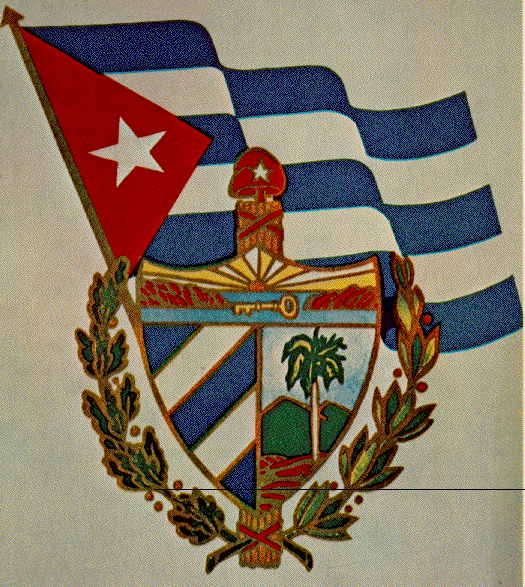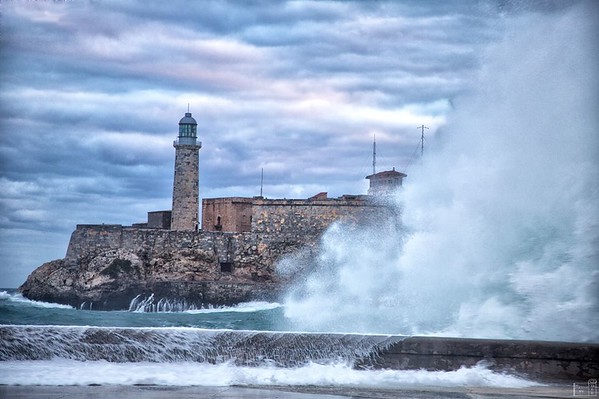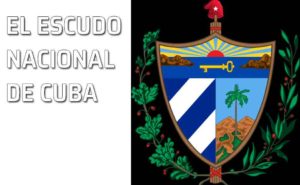THE CUBAN NATIONAL SHIELD (El Escudo Nacional Cubano), THE PUREST REPRESENTATIVE OF OUR ISLAND. PHOTOS
The Cuban National Shield represents our Island. It is formed by two arches of equal circles, which are cut by turning the concavity to each other like an ogival shield, and are divided into three bodies, spaces, or barracks. Cuba, as the key to the Gulf of Mexico, the union of Cubans, the sun of freedom, the colors of the flag, and the typical national landscape, are present in the shield.
In the design there is a red Phrygian cap -emblem adopted by the French Revolution-, turned to the right, which stands out from the top. This cap had been used in ancient times to be worn by men who had obtained freedom. In it appears in its central part, a white five-pointed star, with one of them facing the upper part and, as in the flag, it represents the independent state.
The Shield is held by a bundle of eleven rods, joined by a red ribbon crossed in Xs that signifies the union since this is what gives the force.
The upper horizontal body represents a sea, with two capes, mountains, or land points on its sides, which symbolizes the position of Cuba between the two Americas and the emergence of a new nation. Closes the strait a solid-shank gold key, placed on a navy blue background, with the lever down. In the background, a rising sun spreads its rays throughout the sky of the landscape, which recalls the place of Cuba: the “key to the New World”, the link between America and Europe and between North and South America, as well as the emergence of luminous of the nascent state.
In the lower-left quarter there is in the center a landscape of a flat and mountainous green ground, in a blue and clear sky, which symbolizes our environment in the most natural and typical of its content and where, in its rise, a palm presides over it. the royal palm, the tree that typifies the Cuban, with the button on its central leaf at the top, an emblem of the unyielding character of the people.
The lower right quarter has five bands of equal width, alternated in turquoise blue and white and all inclined from left to right, which is associated with the flag. These white and blue stripes exemplify the departmental division of the Island in colonial times.
Without exceeding its height, a laurel branch and an oak branch adorn the shield to its left and right, respectively. The first represents strength and the second represents victory.
The National Shield is inspired by the one designed by the poet Miguel Teurbe Tolón, under the ideas that Narciso López transmitted to him for the National Flag. The current one differs somewhat from the one originally made in 1849 and which was made to serve as a vignette for the newspaper La Verdad, directed by Teurbe in New York and which was used by López to seal the dispatches and bonds, which as head of the provisional government of Cuba issued between 1850 and 1851.
Its current form was adopted in the Assembly of Guáimaro, when the Republic of Cuba was created. According to Law 42 of the National Assembly, it is the Symbol of the Nation.
EL ESCUDO NACIONAL CUBANO, EL MAS PURO REPRESENTANTE DE NUESTRA ISLA. PHOTOS
El Escudo Nacional Cubano representa a nuestra Isla. Está formado por dos arcos de círculos iguales, que se cortan volviendo la concavidad el uno al otro como una adarga ojival, y está dividido en tres cuerpos, espacios o cuarteles. Cuba, como llave del Golfo de México, la unión de los cubanos, el sol de la libertad, los colores de la bandera y el típico paisaje nacional, están presentes en el escudo.
En el diseño aparece un gorro frigio de color rojo -emblema adoptado por la Revolución Francesa-, vuelto hacia la derecha, que sobresale por la parte superior. Este gorro se había usado en la antigüedad para ser llevado por los hombres que habían obtenido la libertad. En él aparece en su parte central, una estrella blanca de cinco puntas, con una de ellas orientada hacia la parte superior y, al igual que en la bandera, representa el estado independiente.
El Escudo se sostiene por un haz de once varillas, unidas por una cinta roja cruzada en equis que significa la unión, pues esta es la que da la fuerza.
El cuerpo superior horizontal representa un mar, con dos cabos, montañas o puntas terrestres a sus lados, lo cual simboliza la posición de Cuba entre las dos Américas y el surgimiento de una nueva nación. Cierra el estrecho una llave dorada de vástago macizo, colocada en un fondo azul marino, con la palanca hacia abajo. Al fondo un sol naciente esparce sus rayos por todo el cielo del paisaje, que recuerda el lugar de Cuba: la “llave del Nuevo Mundo”, el nexo entre América y Europa y entre el norte y el sur de América, así como el surgir luminoso del naciente estado.
En el cuartel inferior izquierdo figura en el centro un paisaje de un verde suelo llano y montañoso, en un cielo azul y claro, que simboliza nuestro entorno en lo más natural y propio de su contenido y donde preside, en su alzamiento, una palma, la palma real, el árbol que tipifica lo cubano, con el botón de su hoja central en lo más alto, emblema del carácter indoblegable del pueblo.
El cuartel inferior derecho tiene cinco bandas de igual ancho, alternadas de color azul turquí y blanco e inclinadas todas de izquierda a derecha, que se asocian a la bandera. Estas franjas blancas y azules ejemplifican la división departamental de la Isla en la época colonial.
Sin exceder su altura, una rama de laurel y otra de encina orlan el escudo a su izquierda y derecha, respectivamente. La primera representa la fortaleza y la segunda la victoria.
El Escudo Nacional está inspirado en el que diseñara el poeta Miguel Teurbe Tolón, bajo las ideas que le trasmitió Narciso López para la Bandera Nacional. El actual difiere algo del confeccionado originalmente en 1849 y que fue hecho para servir de viñeta al periódico La Verdad, dirigido por Teurbe en New York y el cual fue empleado por López para sellar los despachos y bonos, que como jefe del gobierno provisional de Cuba emitió entre 1850 y 1851.
Su forma vigente fue adoptada en la Asamblea de Guáimaro, al crearse la República de Cuba. Según la Ley 42 de la Asamblea Nacional, es Símbolo de la Nación.
Agencies/ Cubarte/ Various/ Internet Photos/ Arnoldo Varona/ www.TheCubanHistory.com
THE CUBAN HISTORY, HOLLYWOOD.



 THE CUBAN National Shield (El Escudo Nacional Cubano), the purest Representative of Our Island. * EL ESCUDO Nacional Cubano, el Más Puro Representante de Nuestra Isla. PHOTOS.
THE CUBAN National Shield (El Escudo Nacional Cubano), the purest Representative of Our Island. * EL ESCUDO Nacional Cubano, el Más Puro Representante de Nuestra Isla. PHOTOS.





